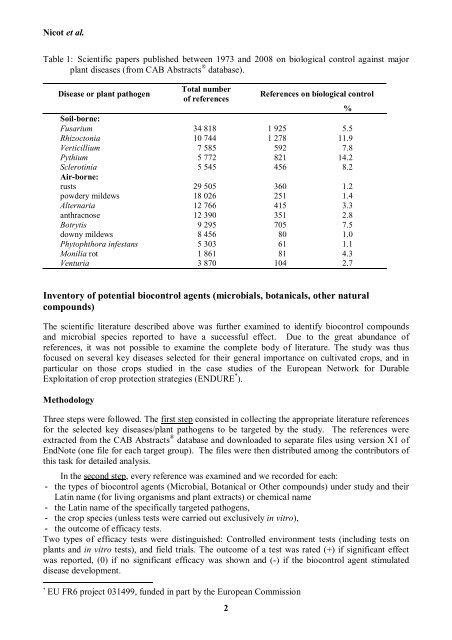Classical and augmentative biological control against ... - IOBC-WPRS
Classical and augmentative biological control against ... - IOBC-WPRS
Classical and augmentative biological control against ... - IOBC-WPRS
You also want an ePaper? Increase the reach of your titles
YUMPU automatically turns print PDFs into web optimized ePapers that Google loves.
Nicot et al.<br />
Table 1: Scientific papers published between 1973 <strong>and</strong> 2008 on <strong>biological</strong> <strong>control</strong> <strong>against</strong> major<br />
plant diseases (from CAB Abstracts ® database).<br />
Disease or plant pathogen<br />
Total number<br />
of references<br />
References on <strong>biological</strong> <strong>control</strong><br />
%<br />
Soil-borne:<br />
Fusarium 34 818 1 925 5.5<br />
Rhizoctonia 10 744 1 278 11.9<br />
Verticillium 7 585 592 7.8<br />
Pythium 5 772 821 14.2<br />
Sclerotinia 5 545 456 8.2<br />
Air-borne:<br />
rusts 29 505 360 1.2<br />
powdery mildews 18 026 251 1.4<br />
Alternaria 12 766 415 3.3<br />
anthracnose 12 390 351 2.8<br />
Botrytis 9 295 705 7.5<br />
downy mildews 8 456 80 1.0<br />
Phytophthora infestans 5 303 61 1.1<br />
Monilia rot 1 861 81 4.3<br />
Venturia 3 870 104 2.7<br />
Inventory of potential bio<strong>control</strong> agents (microbials, botanicals, other natural<br />
compounds)<br />
The scientific literature described above was further examined to identify bio<strong>control</strong> compounds<br />
<strong>and</strong> microbial species reported to have a successful effect. Due to the great abundance of<br />
references, it was not possible to examine the complete body of literature. The study was thus<br />
focused on several key diseases selected for their general importance on cultivated crops, <strong>and</strong> in<br />
particular on those crops studied in the case studies of the European Network for Durable<br />
Exploitation of crop protection strategies (ENDURE * ).<br />
Methodology<br />
Three steps were followed. The first step consisted in collecting the appropriate literature references<br />
for the selected key diseases/plant pathogens to be targeted by the study. The references were<br />
extracted from the CAB Abstracts ® database <strong>and</strong> downloaded to separate files using version X1 of<br />
EndNote (one file for each target group). The files were then distributed among the contributors of<br />
this task for detailed analysis.<br />
In the second step, every reference was examined <strong>and</strong> we recorded for each:<br />
- the types of bio<strong>control</strong> agents (Microbial, Botanical or Other compounds) under study <strong>and</strong> their<br />
Latin name (for living organisms <strong>and</strong> plant extracts) or chemical name<br />
- the Latin name of the specifically targeted pathogens,<br />
- the crop species (unless tests were carried out exclusively in vitro),<br />
- the outcome of efficacy tests.<br />
Two types of efficacy tests were distinguished: Controlled environment tests (including tests on<br />
plants <strong>and</strong> in vitro tests), <strong>and</strong> field trials. The outcome of a test was rated (+) if significant effect<br />
was reported, (0) if no significant efficacy was shown <strong>and</strong> (-) if the bio<strong>control</strong> agent stimulated<br />
disease development.<br />
*<br />
EU FR6 project 031499, funded in part by the European Commission<br />
2

















